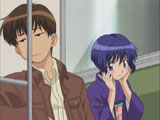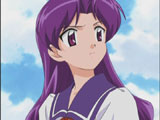

Quick Links:
Ai Yori Aoshi (More Blue than Indigo)
Love is a fleeting, if volatile emotion. Very few actually experience it, and even fewer are able to hold onto those they love. Ai Yori Aoshi is the touching tale of Kaoru Hanabishi and Aoi Sakuraba: two that have been separated for eighteen years before being reunited. A simple tale of love, loss, and perseverence, Ai Yori Aoshi is a series that just about anybody can watch, and fall in love with.
The series starts off as a romantic drama with a hint of comedy to keep things fresh. However, by the fifth episode, the series manages to make a complete turnaround into a harem series. Despite the change in pace, the series manages to keep its intentions pure: the series still revolves mostly around Aoi and Kaoru and their trials. The other characters merely serve to flesh out the storyline. New members of the cast are introduced gradually, which helps to keep the series from falling into the biggest pitfall of harem shows: too many characters with too little development. The characters begin to mesh with each other, becoming intertwined while creating a richer, fuller world. Sadly, while the series does become an excellent harem show in the end, it loses much of the impact of the beginning episodes. As much as it desperately tries to regain its lost momentum, Ai Yori Aoshi only manages to become a shadow of its former self.
To complement the plot, Ai Yori Aoshi sports wonderful character designs. Fumizuki's original characters undergo a vast improvement in their transition to the small screen, with the somewhat generic designs of the manga receiving a much-needed injection of personality for the television series. However, at the core, the characters are still what readers fell in love from the beginning. Kaoru is still the all-around nice guy with a tortured past, and Aoi is still the ever-loving maiden that is willing to do anything for her Kaoru. Unfortunately, the character of Mayu seems to add little to the series, and rarely amounts to more than an annoying pest. Still, despite the single "kink" in the series with Mayu, the characters are very well-made in all regards, and even outshine their manga counterparts.
To create a truly beautiful show, it requires animation as beautiful as its characters. Ai Yori Aoshi manages to achieve this feat with gorgeous, almost OVA-quality animation. The silky smooth character movement is a treat for the eyes when compared to other shows of the genre.
Possibly the highest point of Ai Yori Aoshi as a whole, though, is its music. The series' mix of tunes helps to set the mood for any situation. Be it a haunting, melancholy piece or a lilting cheerful melody, each composition is well-written and stays in both the mind and heart. The opening theme, Eternal Flower, is a beautiful piece by Yoko Ishida that perfectly captures the feelings of young love. The ending theme, A Flower Without a Name, is a more reflective piece by The Indigo that accurately captures the more uncertain side of a relationship: the doubts and the fears.
A series of high caliber, Ai Yori Aoshi belongs in every anime fan's collection. Despite its disappointing fall from a powerful drama to a harem show, Ai Yori Aoshi still manages to tug at the heart-strings of even the most jaded fan. The series' sweet, slice of life situations still carriy their own weight, and uphold the namesake of "True Blue Love."
Distributor: Geneon Creator: Kou Fumizuki/AiAo Project Released: 2002-2003
Plot: B- Character Design: A- Animation Quality: A- Music: A Overall: A-



